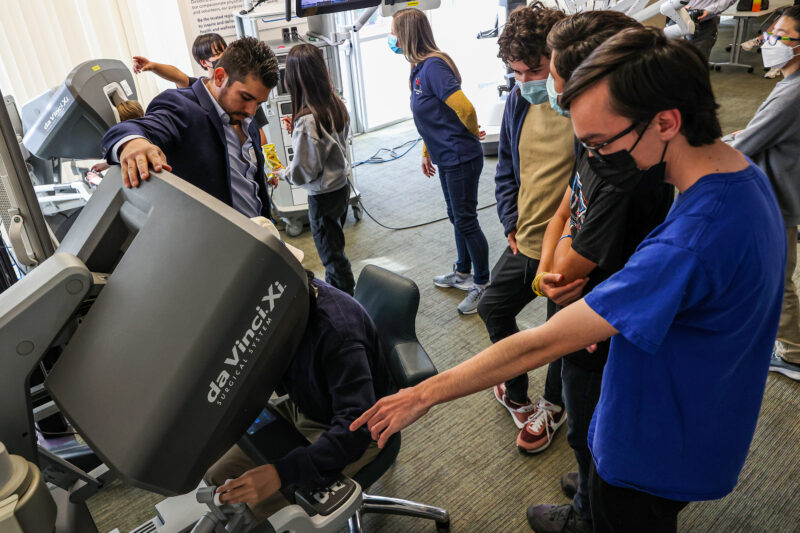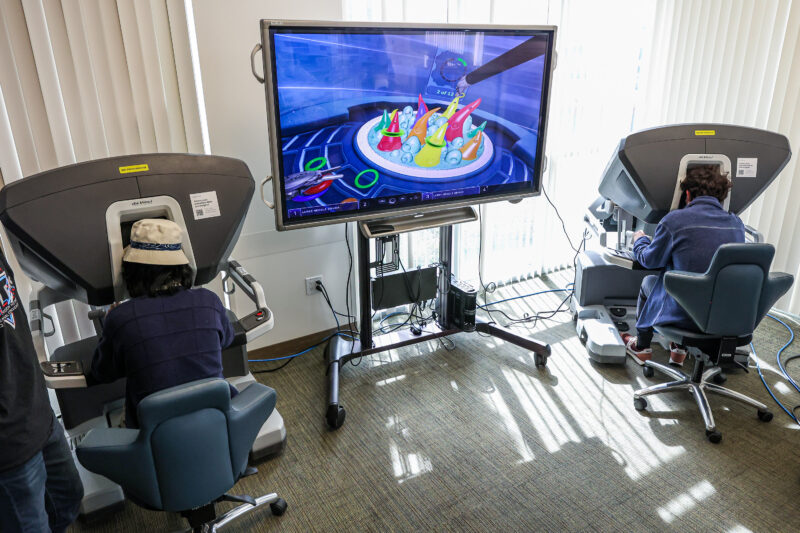The local students delicately pinched their fingers, deftly manipulated their wrists and gently worked the pedals, not unlike having a turn on the most expensive digital game they’ve ever touched.
Henry Mayo Newhall Hospital hosted several local junior highs and a high school Friday for a robotics competition, an opportunity for learning and also a chance to demonstrate its state-of-the-art tech with students who could be a part of the next generation of doctors.

“We did this to raise awareness about Henry Mayo having this technology available to the community,” said Patrick Moody, spokesman for the hospital, who invited the programs to participate.
The competition featured contestants from Arroyo Seco, Placerita and Rio Norte junior highs, with students from Hart High robotics there to mentor, as the teams competed to see who could earn the highest score by playing a game.


The game, “Sea Spikes,” is a training exercise for the $2 million robotic surgery machine on display at the hospital’s Henry Mayo Center, where students encouraged and cajoled each other as their scores popped up on a large screen.
The competition gave students interested in robotics a chance to learn and experience a real-life application of their lesson plans.
Owen Rusk, a Hart High junior who’s co-president of his school’s robotics club along with Allen Alvarez, earned the highest score by the end of the competition.
Both Hart students talked about how contests like Friday’s are what the club is all about, a chance to have fun exploring robotics with whoever wants to learn about them.


“We’re dedicated to just giving opportunities to people on and off campus that want to come to mess around, play with robots, learn how to solder, learn how to code and apply their knowledge in physics and engineering. It’s just a space to apply your knowledge,” Alvarez said.
“And we welcome anyone who wants to join,” Rusk added. “It’s entirely open to anyone.”
Rusk’s deft maneuvering with the surgical robots’ arms, placing as many tiny plastic rings around very small cones as he could in three minutes — earned a $100 donation to his school’s robotics program.
Rusk’s score was just three points away from that of Dr. Sevan Stepanian, a urology surgeon at Henry Mayo trained in using the Da Vinci. Stepanian took part in the fun Friday to share with students how their robotics lessons have real-life applications.


There also were several correlations brought up during the competition between the skills used in video games and those on display at the hospital Friday, with Stepanian mentioning a study that a number of the students found encouraging.
He called the Da Vinci technology, which Henry Mayo first started using in 2017, a “game-changer” for the hospital, because it not only helped improve patient outcomes by making the procedures less invasive, it also helps draw talent, as the use of robots is part of the future for surgical techniques.
After he admitted to aging himself in the young crowd by saying he grew up playing a Sega Genesis, a popular gaming console in the 1990s, he noted research that indicated the benefits of playing video games in honing the types of skills needed to operate surgical robots.


“There’s studies that have looked at surgeons in residency training that have actually had some experience growing up with video games — and they tend to do a little bit better with certain types of tasks,” Stepanian said, which immediately resonated with one student.
“What you’re saying is, I can tell my parents that video games aren’t evil,” joked Rio Norte seventh-grader Khloe Urquico, when Stepanian took questions.


“You can train with them,” he answered back with a laugh.
A game-changer indeed.








